Windows Store Economics and Developer Opportunities
In the article “ Developing Applications for Windows 8: Why and How, ” we touched on the idea of developing for Windows 8. As you know, it was said there, the Windows Store, the Windows 8 application store, is one of the key components of the new system and an important component of its success, as well as well as the success of developers who decided to create applications for Windows 8.

For those who doubt the possibilities that Windows 8 provides for developers, or do not fully understand the meaning of the Windows Store, we decided to review the very idea and the possibilities that the Store gives.
The Windows Application Store itself is built according to a scheme that has already become classic.
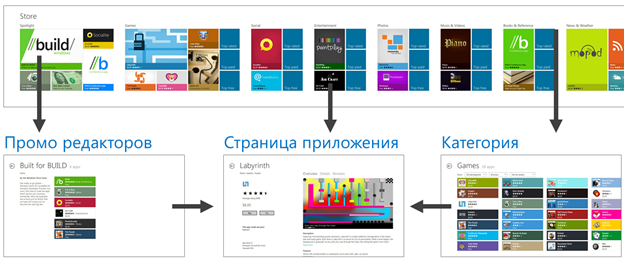
This is a separate application available in every Windows 8 installation. It is connected to a central directory where developers publish their applications.
Windows Store contains several sections: one for each category of applications (games, social applications, entertainment, etc.) and the very first section is an editorial promo.
Moreover, each category has its own promo. Here, for example, how it looks now in the Games category:

You can see that there are, as is already accepted, all sorts of top lists, lists of new applications and "rising stars".
On the page of a separate application, of course, there are all the necessary information and tools: description, screenshots, etc.
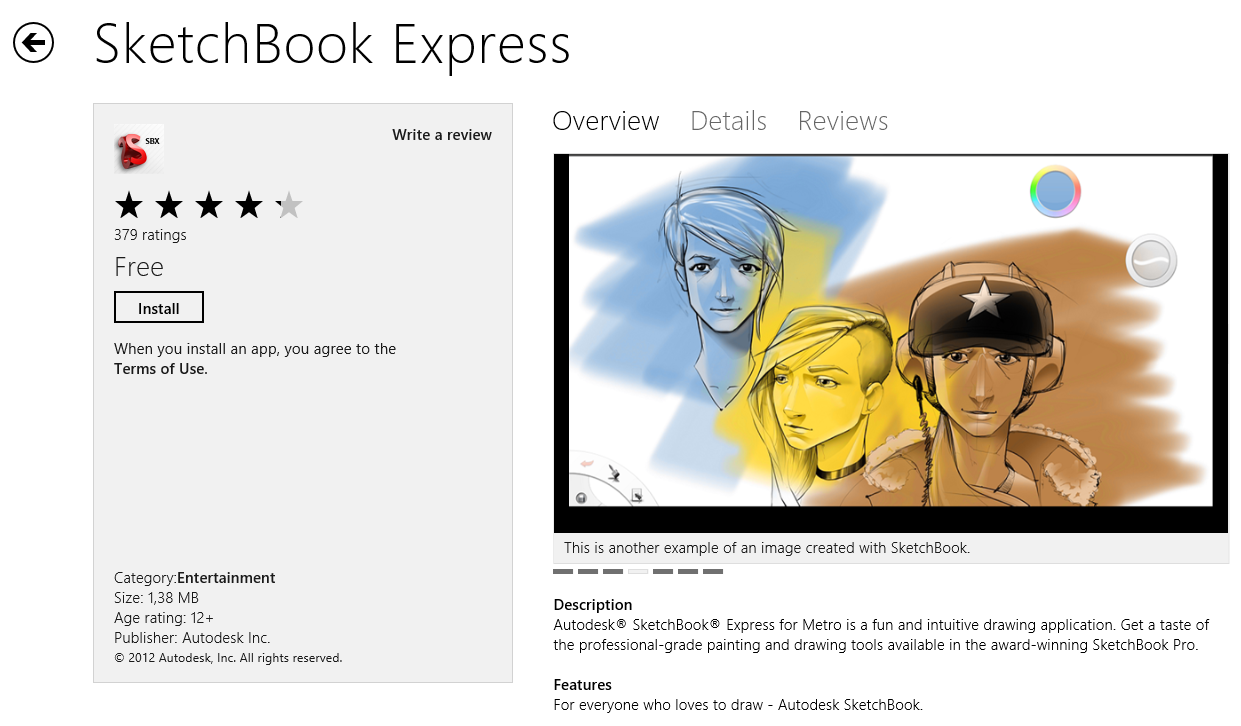
If you decide to distribute applications through Windows Store, then you should know about the basic rules that work there.
It all starts with registering a developer account. It costs $ 49 per year for individual developers and $ 99 per year for legal entities. Like any similar structure of the Windows Store, it works according to certain rules, also setting requirements for published applications that are certified before they appear in the Store:
A good tool for the developer is the Windows App Certification Kit (WACK). This is an automatic tool that allows you to find problems in the application before it is published.
Each developer has two main application sales schemes: paid and free. At the same time, the platform itself and the corresponding API support trial versions of two types of applications: with a time limit ( controlled by the system automatically ) and by functionality (the application functionality in the trial mode is determined by it itself).
')
Naturally, today built-in advertising is one of the main sources of income for developers. We support our own advertising engine, Microsoft Advertising, with the appropriate SDK and controls for the user interface. Another thing is that no one bothers you to build your own advertising mechanism into the application.
Windows Store has a built-in in- app purchases mechanism and corresponding API. An important feature of the Windows Store is the ability to use its payment mechanisms within the application. This will not only allow you to work with the tools you are used to, but also eliminates the need to share income with the Windows Store.
By the way, about the division of income. As long as the income received for the application does not exceed $ 25,000, it is divided according to the 70/30 scheme: 70% are received by the developer, 30% by Microsoft. As soon as revenue exceeds $ 25K, the developer already receives 80% of the revenue from the application .

To begin with, oddly enough, let us turn to the editors of Windows 8. There are only three:
The first and second are intended for devices with the traditional for PC architecture (x86 / x64), the third - exclusively for devices with ARM architecture, characterized, as a rule , by lower power consumption and dimensions. Now, speaking of Windows RT, we primarily mean tablets.
On Windows and Windows Pro, both classic desktop and metro applications will work. At the same time, on any computer that has the label “Designed for Windows 7” or de facto falls under this status, you can not only install Windows 8, but also fully work with it.
With Windows RT everything is different. This system runs on an ARM architecture and existing desktop applications cannot run on it. Another thing is that for Metro-applications Microsoft guarantees execution on both types of systems - both Windows / Windows Pro and Windows RT. Even for applications written in C ++ and compiled into native code, you only need to make the appropriate assembly and include it in the application packages when it is published in the Windows Store. Again, this only works for Metro applications. Moreover, in Windows RT, with the exception of certain corporate scenarios, it will be possible to install applications only from the Windows Store.
Thus, developing applications in the Metro style, you get as potential users and buyers of all who install Windows 8 or buy a device with it - regardless of the type of this device.
It's no secret that with Windows 8 Microsoft is actively promoting the idea of using touch-screens on all categories of devices - from tablets to desktops with huge monitors (of course, also touch). This idea is very well perceived by device manufacturers and many users. Of course, not all scenarios are suitable touch-interface. That is why it is so important in all metro-applications to support the work with the keyboard and mouse. Naturally, in Windows 8 and Windows 8 Pro there is an ordinary desktop and all applications familiar to us work. By the way, even in Windows RT a special ARM version of MS Office will be delivered, which works in the desktop mode.
Chris Kapossela, Microsoft’s vice president of marketing, once said, “If it’s a bad gift,” Gadgets - this is what today can really interest people.
Computex 2012 has become a real exhibition of Windows 8 devices. Many ultrabooks (most of which, by the way, touch-screens), as well as all-in-one systems, saw the light of day.

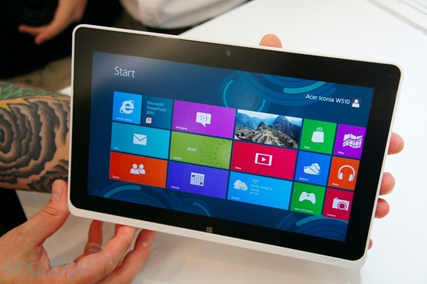

Naturally, you can not ignore the latest device from Microsoft - Surface .
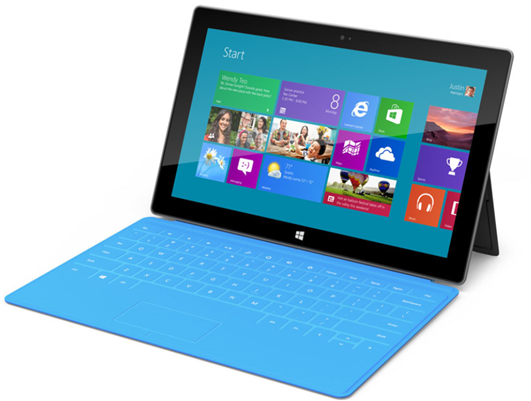
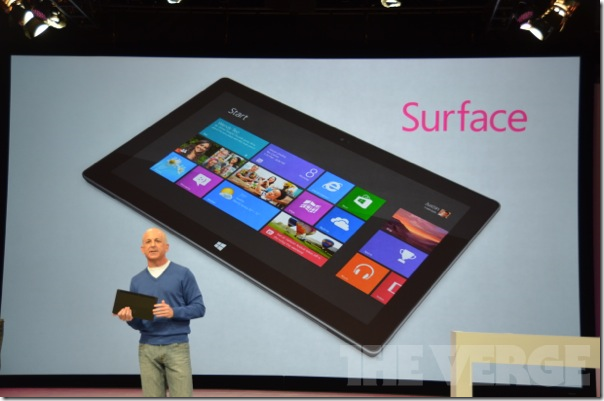
It is noteworthy that the tablets will work not only on ARM and Window RT. The latest chipsets from Intel allow to achieve acceptable power consumption in the tablet form factor.
These and many other computers in various versions will be sold this fall with Windows 8 on board. And their customers at the same time become potential buyers of your applications published in the Windows Store. People in more than 200 countries, speaking more than 100 languages will begin to buy your applications.

Who is the second largest group of potential users of applications from the Windows Store? That's right, users of previous versions of Windows. What will push them to upgrade? Three simple but working factors:
1. New attractive devices.
2. New consumer properties of Windows 8 (for example, increased battery life).
3. Low price upgrade to Windows 8 - only $ 40 for all legal users of Windows XP, Windows Vista and Windows 7.

There is one more important factor - your new applications.
Last year alone, Windows 7 has sold 230 million copies. The total licenses sold reached 630 million . And this is only Windows 7. And only legal users. Today, there are more than a billion Windows users on Earth, but even those who have bought Windows 7 since its launch are more than buyers of iOS, Android, and OSX devices combined , sold for the same time. And in fact, the lion's share of buyers iOS and Android also use Windows.

Let's do some exercise in arithmetic.
Suppose you want $ 1 million in revenue by selling an app in the Windows Store. Let the app cost $ 1.99.

So, you need to sell the application about 503 thousand times. But this is only 0.08% of today's legal users of Windows 7 . Eight ten thousandths of the total.

Or your application is free , but it works according to the Freemium scheme. Let something that is sold inside the app cost $ 1.99 too.
Imagine that on average every tenth person spends $ 1.99 in your application. Someone more, someone less, someone does not spend at all, but on average it turns out that 10% buy once at $ 1.99 .
What happens if the application downloads half a percent of the number of current users of Windows 7? You will receive almost $ 630,000 in revenue.
If you are interested in Windows Store, then you should start, of course, with the development of the application. As a starting point, you can use the article " Developing applications for Windows 8: why and how ." Learn more about the Windows Store itself here .
Now it is also important that free registration for developers in the Windows Store is not yet open. If you want to appear there before others, having secured your niche or even occupying someone else’s, you need to receive a special invitation. The order of its receipt is described here: " Invite on the Windows Store or how to get into Windows 8 ".


For those who doubt the possibilities that Windows 8 provides for developers, or do not fully understand the meaning of the Windows Store, we decided to review the very idea and the possibilities that the Store gives.
Windows Store
The Windows Application Store itself is built according to a scheme that has already become classic.

This is a separate application available in every Windows 8 installation. It is connected to a central directory where developers publish their applications.
Windows Store contains several sections: one for each category of applications (games, social applications, entertainment, etc.) and the very first section is an editorial promo.
Moreover, each category has its own promo. Here, for example, how it looks now in the Games category:

You can see that there are, as is already accepted, all sorts of top lists, lists of new applications and "rising stars".
On the page of a separate application, of course, there are all the necessary information and tools: description, screenshots, etc.

Windows Store Technology
If you decide to distribute applications through Windows Store, then you should know about the basic rules that work there.
It all starts with registering a developer account. It costs $ 49 per year for individual developers and $ 99 per year for legal entities. Like any similar structure of the Windows Store, it works according to certain rules, also setting requirements for published applications that are certified before they appear in the Store:
A good tool for the developer is the Windows App Certification Kit (WACK). This is an automatic tool that allows you to find problems in the application before it is published.
Free / Paid / Trial
Each developer has two main application sales schemes: paid and free. At the same time, the platform itself and the corresponding API support trial versions of two types of applications: with a time limit ( controlled by the system automatically ) and by functionality (the application functionality in the trial mode is determined by it itself).
')
Advertising
Naturally, today built-in advertising is one of the main sources of income for developers. We support our own advertising engine, Microsoft Advertising, with the appropriate SDK and controls for the user interface. Another thing is that no one bothers you to build your own advertising mechanism into the application.
In-app purchase
Windows Store has a built-in in- app purchases mechanism and corresponding API. An important feature of the Windows Store is the ability to use its payment mechanisms within the application. This will not only allow you to work with the tools you are used to, but also eliminates the need to share income with the Windows Store.
Revenue sharing
By the way, about the division of income. As long as the income received for the application does not exceed $ 25,000, it is divided according to the 70/30 scheme: 70% are received by the developer, 30% by Microsoft. As soon as revenue exceeds $ 25K, the developer already receives 80% of the revenue from the application .

Windows Store Audience
To begin with, oddly enough, let us turn to the editors of Windows 8. There are only three:
- Windows
- Windows pro
- Windows RT
The first and second are intended for devices with the traditional for PC architecture (x86 / x64), the third - exclusively for devices with ARM architecture, characterized, as a rule , by lower power consumption and dimensions. Now, speaking of Windows RT, we primarily mean tablets.
On Windows and Windows Pro, both classic desktop and metro applications will work. At the same time, on any computer that has the label “Designed for Windows 7” or de facto falls under this status, you can not only install Windows 8, but also fully work with it.
With Windows RT everything is different. This system runs on an ARM architecture and existing desktop applications cannot run on it. Another thing is that for Metro-applications Microsoft guarantees execution on both types of systems - both Windows / Windows Pro and Windows RT. Even for applications written in C ++ and compiled into native code, you only need to make the appropriate assembly and include it in the application packages when it is published in the Windows Store. Again, this only works for Metro applications. Moreover, in Windows RT, with the exception of certain corporate scenarios, it will be possible to install applications only from the Windows Store.
Thus, developing applications in the Metro style, you get as potential users and buyers of all who install Windows 8 or buy a device with it - regardless of the type of this device.
It's no secret that with Windows 8 Microsoft is actively promoting the idea of using touch-screens on all categories of devices - from tablets to desktops with huge monitors (of course, also touch). This idea is very well perceived by device manufacturers and many users. Of course, not all scenarios are suitable touch-interface. That is why it is so important in all metro-applications to support the work with the keyboard and mouse. Naturally, in Windows 8 and Windows 8 Pro there is an ordinary desktop and all applications familiar to us work. By the way, even in Windows RT a special ARM version of MS Office will be delivered, which works in the desktop mode.
New devices for Windows 8
Chris Kapossela, Microsoft’s vice president of marketing, once said, “If it’s a bad gift,” Gadgets - this is what today can really interest people.
Computex 2012 has become a real exhibition of Windows 8 devices. Many ultrabooks (most of which, by the way, touch-screens), as well as all-in-one systems, saw the light of day.



Naturally, you can not ignore the latest device from Microsoft - Surface .


It is noteworthy that the tablets will work not only on ARM and Window RT. The latest chipsets from Intel allow to achieve acceptable power consumption in the tablet form factor.
These and many other computers in various versions will be sold this fall with Windows 8 on board. And their customers at the same time become potential buyers of your applications published in the Windows Store. People in more than 200 countries, speaking more than 100 languages will begin to buy your applications.

Windows 7
Who is the second largest group of potential users of applications from the Windows Store? That's right, users of previous versions of Windows. What will push them to upgrade? Three simple but working factors:
1. New attractive devices.
2. New consumer properties of Windows 8 (for example, increased battery life).
3. Low price upgrade to Windows 8 - only $ 40 for all legal users of Windows XP, Windows Vista and Windows 7.

There is one more important factor - your new applications.
Last year alone, Windows 7 has sold 230 million copies. The total licenses sold reached 630 million . And this is only Windows 7. And only legal users. Today, there are more than a billion Windows users on Earth, but even those who have bought Windows 7 since its launch are more than buyers of iOS, Android, and OSX devices combined , sold for the same time. And in fact, the lion's share of buyers iOS and Android also use Windows.

Windows Store Economy
Let's do some exercise in arithmetic.
Suppose you want $ 1 million in revenue by selling an app in the Windows Store. Let the app cost $ 1.99.
So, you need to sell the application about 503 thousand times. But this is only 0.08% of today's legal users of Windows 7 . Eight ten thousandths of the total.
Freemium
Or your application is free , but it works according to the Freemium scheme. Let something that is sold inside the app cost $ 1.99 too.
Imagine that on average every tenth person spends $ 1.99 in your application. Someone more, someone less, someone does not spend at all, but on average it turns out that 10% buy once at $ 1.99 .
What happens if the application downloads half a percent of the number of current users of Windows 7? You will receive almost $ 630,000 in revenue.
Interested?
If you are interested in Windows Store, then you should start, of course, with the development of the application. As a starting point, you can use the article " Developing applications for Windows 8: why and how ." Learn more about the Windows Store itself here .
Now it is also important that free registration for developers in the Windows Store is not yet open. If you want to appear there before others, having secured your niche or even occupying someone else’s, you need to receive a special invitation. The order of its receipt is described here: " Invite on the Windows Store or how to get into Windows 8 ".

useful links
- Windows Store App Developer Agreement
- Certification requirements for Windows apps
- Report of Mikhail Chernomordikov " Windows Store application store "
Source: https://habr.com/ru/post/147697/
All Articles